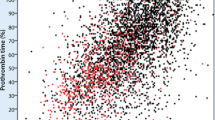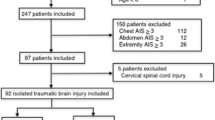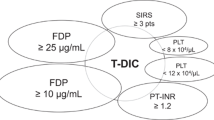Abstract
A total of 138 autopsies performed at the Institute of Legal Medicine of the University of Münster between 1994 and 2006 were subdivided into two groups: (1) 69 asphyxial deaths with a blood alcohol level (BAL) > 1‰ and (2) 69 asphyxial deaths with a BAL of 0.00‰. The coagulation state in the central vessels was registered in all cases as fluid, compactly clotted or loosely clotted, and the post-mortem interval was recorded. Histology investigations were performed on the liver to analyze the incidence of hepatic fibrosis/cirrhosis. Fisher’s exact test was performed to check for statistical significance. The blood was found to be clotted in 49.3% of the cases of group (1) and in 5.8% of group (2) (p < 0.01). The post-mortem interval did not have any influence on the coagulation state as observed in both groups. Liver fibrosis/cirrhosis was a rare finding detected in three cases in group 1 and in two cases in the control group 2 and, therefore, not relative to our observations. A distinctly positive BAL is often associated with heavy stages of blood coagulation as observed during autopsy. Distinctly positive alcohol concentrations have an influence on the fibrinolytic process and, hence, on the coagulation status.

Similar content being viewed by others
References
Schloegl H, Dresen S, Spaczynski K, Stoertzel M, Wurst FM, Weinmann W (2006) Stability of ethyl glucuronide in urine, post-mortem tissue and blood samples. Int J Legal Med 120:83–88
Koski A, Vuori E, Newer I (2005) Antidepressants: evaluation of fatal toxicity index and interaction with alcohol based on Finnish postmortem data. Int J Legal Med 119:244–248
Hoiseth G, Kristoffersen L, Larssen B, Arnestad M, Hermansen NO, Morland J (2007) In vitro formation of ethanol in autopsy samples containing fluoride ions. Int J Legal Med 121:85–89
Boumba VA, Ziavrou KS, Vougiouklakis T (2007) Biochemical pathways generating post-mortem volatile compounds co-detected during forensic ethanol analyses. Forensic Sci Int (in press). DOI 10.1016/j.forsciint.2007.03.018
Huckenbeck W, Bonte W (2003) Sektionsbefund bei Alkoholvergiftung und chronischem Missbrauch. In: Madea B, Brinkmann B (Hrsg ) (ed) Handbuch Gerichtliche Medizin, Band II. Springer, Berlin Heidelberg New York, p 427
Mueller B (1953) Tödliche Alkoholvergiftung. In: Mueller B (Hrsg) Gerichtliche Medizin. Springer, Berlin Heidelberg New York, pp 773–774
Brettel H-F (1986) Die tödliche Alkoholvergiftung. In: Forster B (Hrsg) Praxis der Rechtsmedizin. Georg Thieme, Stuttgart, Germany, pp 466–467
Prokop O (1976) Die tödliche Alkoholvergiftung und plötzliche Todesfälle bei Alkoholikern. In: Prokop O, Göhler W (Hrsg) Forensische Medizin. Fischer, Stuttgart, Germany, pp 369–370
Maxeiner H (2003) Gewaltsame Erstickung. In: Madea B (ed) Praxis rechtsmedizin. Springer, Berlin Heidelberg New York, pp 147–152
Adebahr G (1969) Der forensische Beweiswert von Befunden an der Leiche. Beitr Gerichtl Med 25:44–50
Desmet VJ, Gerber M, Hoofnagle JH, Manns M, Scheuer PJ (1994) Classification of chronic hepatitis: diagnosis, grading and staging. Hepatology 19:1513–1520
Weiler G, Adebahr G, Klöppel A (1980) Zum diagnostischen Wert von “geronnenem” Herzblut bei akutem Erstickungstod. Z Rechtsmed 85:23–27
Mukamal KJ, Jadhav PP, D’Agostino RB et al (2001) Alcohol consumption and hemostatic factors: analysis of the Framingham offspring cohort. Circulation 104:1367–1373
Mukamal KJ, Massaro JM, Ault KA et al (2005) Alcohol consumption and platelet activation and aggregation among women and men: the Framingham offspring study. Alcohol Clin Exp Res 29:1906–1912
Dakeishi M, Iwata T, Ishii N, Murata K (2004) Effects of alcohol consumption on hepatocellular injury in Japanese men. Tohoku J Exp Med 202:31–39
Baysan O, Kaptan K, Erinç K et al (2005) Chronic heavy ethanol consumption is associated with decreased platelet aggregation in rats. Tohoku J Exp Med 206:85–90
Brecher AS, Adamu MT (2001) Coagulation protein function: enhancement of the anticoagulant effect of acetaldehyde by sulfated glycosaminoglycans. Dig Dis Sci 46:2033–2042
Basista MH, Joseph A, Smolen S, Koterba A, Brecher AS (1994) Acetaldehyde alters coagulation protein function. Dig Dis Sci 39:2421–2425
Brecher A, Koterba AP, Basista MH (1996) Coagulation protein function. III. Effect of acetaldehyde upon the activation of prothrombin. Alcohol 13:423–429
Brecher AS, Koterba AP, Basista MH (1996) Coagulation protein function. IV. Effect of acetaldehyde upon factor X and Xa, the proteins at the gateway to the common coagulation pathway. Alcohol 13:539–545
Brecher AS, Hellman K, Dulin C, Basista MH (1998) Coagulation protein function. V. Diminution of antithrombin III function by acetaldehyde. Dig Dis Sci 43:1746–1751
Sabol DA, Basista MH, Brecher AS, Haider K, Kleshinski J (1999) Coagulation protein function. VII. Diametric effects of acetaldehyde on factor VII and factor IX function. Dig Dis Sci 44:2564–2567
Brecher AS, Adamu (2002) MT short- and long-term effects of acetaldehyde on plasma. Alcohol 26:49–53
Hansagi H, Romelsjö A, Gerhardsson de Verdier M, Andreasson S, Leifman A (1995) Alcohol consumption and stroke mortality. Stroke 26:1768–1773
Booyse FM, Parks DA (2001) Moderate wine and alcohol consumption: beneficial effects on cardiovascular disease. Thromb Haemost 86:517–528
Murray RP, Connett JE, Tyas SL, Bond R, Ekuma O, Silversides CK, Barnes GE (2002) Alcohol volume, drinking pattern and cardiovascular disease morbidity and mortality: is there a U-shaped function? Am J Epidemiol 155:242–248
Davidson DM (1989) Cardiovascular effects of alcohol. West J Med 151:430–439
Numminen H, Syrjälä M, Benthin G, Kaste M, Hillbom M (2000) The effect of acute ingestion of a large dose of alcohol on the hemostatic system and its circadian variation. Stroke 31:1269–1273
Sasaki A, Kurisu A, Ohno M, Ikeda Y (2001) Overweight/obesity, smoking and heavy alcohol consumption are important determinants of plasma PAI-1 levels in healthy men. Am J Med Sci 322:19–23
Patrono C, Ciabattoni G, Pugliese F, Pierucci A, Blair IA, FitzGerald GA (1986) Estimated rate of thoromboxane secretion into the circulation of normal humans. J Clin Invest 77:590–594
Catella F, FitzGerald GA (1987) Paired analysis of urinary thromboxane B2 metabolites in humans. Thromb Res 47:647–656
Van de Wiel A, van Golde PM, Kraaijenhagen RJ, von dem Borne PAK, Bouma BN, Hart HC (2001) Acute inhibitory effect of alcohol on fibrinolysis. Eur J Clin Invest 31:164–170
De Lange DW, Hijmering ML, Lorsheyd A, Scholman WLG, Kraaijenhagen RJ, Akkerman JWN, van de Wiel A (2004) Rapid intake of alcohol (binge drinking) inhibits platelet adhesion to fibrinogen under flow. Alcohol Clin Exp Res 28:1562–1568
Collins GB, Brosnihan KB, Zuti RA, Messina M, Gupta MK (1992) Neuroendocrine, fluid balance, and thirst response to alcohol in alcoholics. Alcohol Clin Exp Res 16:229–233
Parlesak A, Pohl C, Bode JC, Bode C (2004) Water metabolism in rats subjected to chronic alcohol administration. Nephron Physiol 97:9–15
Marsano L, McClain CJ (1989) Effects of alcohol on electrolytes and minerals. Alcohol Health and Research World, US Government Printing Office, USA
Berg SP (1950) Das postmortale Verhalten des Blutes. Z Gerichtl Med 40:1–75
Berg S (1963) Physiologisch-chemische Befunde im Leichenblut als Ausdruck des Todesgeschehens. Z Gerichtl Med 54:136–149
Tacheiki S, Wakasugi C, Shikata I (1984) Fluidity of the blood after sudden death: Part I. Am J Forensic Med Pathol 5:223–227
Tacheiki S, Wakasugi C, Shikata I (1985) Fluidity of the blood after sudden death: Part II. Am J Forensic Med Pathol 6:25–29
Tacheiki S, Tokunaga I, Hayakumo K, Maeiwa M (1986) Fluidity of the blood after sudden death: Part III. Am J Forensic Med Pathol 7:35–38
Author information
Authors and Affiliations
Corresponding author
Rights and permissions
About this article
Cite this article
Fracasso, T., Brinkmann, B., Beike, J. et al. Clotted blood as sign of alcohol intoxication: a retrospective study. Int J Legal Med 122, 157–161 (2008). https://doi.org/10.1007/s00414-007-0185-3
Received:
Accepted:
Published:
Issue Date:
DOI: https://doi.org/10.1007/s00414-007-0185-3




